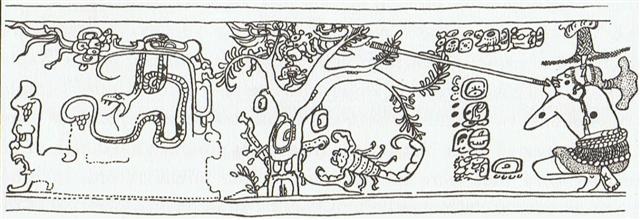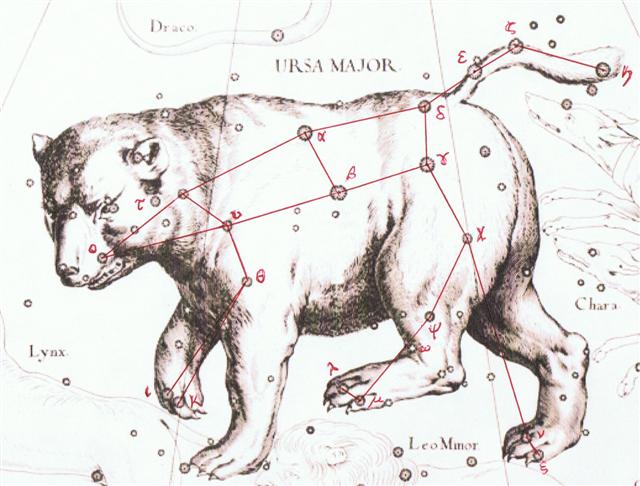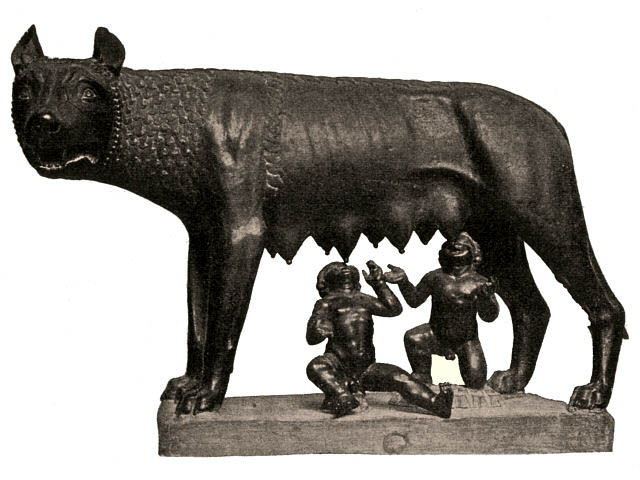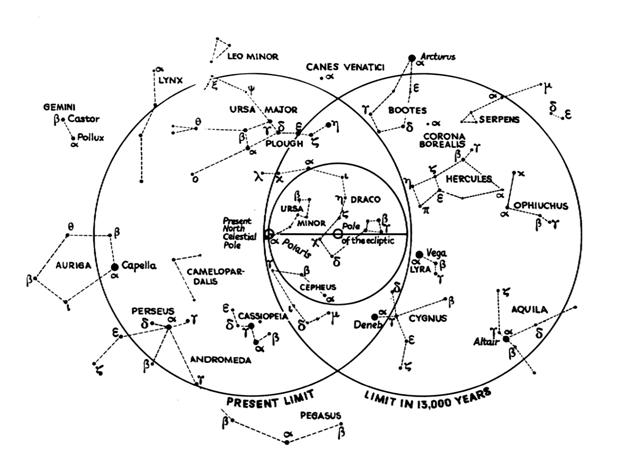225. When Ursa Major no
longer was at the north pole he was brought
down:
... I became curious about this star ...
called Nuutuittuq [= 'never moves']
... So, on the lee side of our uquutaq
(a snow windbreak) I positioned a harpoon
pointing directly at this particular star to
see if it would move. In the morning I
checked it and discovered that the
Tukturjuit (Ursa Major) had changed
their position completely but the harpoon
still pointed at this star ... I had
discovered the stationary star ...

... This pot depicts one of the Hero Twins (One-Ahaw
in the Classic texts and
One-Hunaphu
in the K'iche´ Popol Vuh) and a great bird
who is trying to land in a huge
ceiba
tree heavy with fruit.
|
... I already knew that the ceiba
tree was the model for the sacred
World Tree of the Maya, but I had
never seen one in flower when I knew
what I was looking at. I was really
excited because normally you can't
see the blossoms even if you're
there when the tree is in blossom.
The fully mature trees are hundreds
of feet high and the blossoms are
very small. It's a ceiba, I chirped
and began looking for a branch low
enough to see one of the blossoms up
close. Joyce Livingstone, a retired
teacher, did the logical thing. She
bent over, picked up a fallen
branch, and held it out for me to
see. I was too excited and full of
myself to listen. She tapped my arm
more insistently and still I didn't
hear her. Finally, in frustration,
she grabbed my wrist and raised her
voice, Will you look at these? she
said, waving the branch, and finally
I did. What I saw stunned me, for in
her hand lay a perfect replica of
the earflares worn by the Classic
Maya kings. Suddenly I understood
the full symbolism of so many of the
things I had been studying for
years. The kings dressed themselves
as the Wakah-Chan tree,
although at the time I didn't know
it was also the Milky Way.
...
The branches with their white
flowers bent down along their
thighs, the double-headed ecliptic
snake rested in their arms, and the
great bird Itzam-Yeh
stood on their head. I already knew
as I stood under the young tree in
Tikal that the kings were the human
embodiment of the ceiba as the
central axis of the world. As I
stood there gazing at the flowers in
Joyce's hand, I also learned that
the kings embodied the ceiba at the
moment it flowers to yield the
sak-nik-nal, the 'white
flowers', that are the souls of
human beings. As the trees flowers
to reproduce itself, so the kings
flowered to reproduce the world ...
|
This mythical bird is Itzam-Yeh,
Classic prototype of
Wuqub-Kaqix,
'Seven-Macaw', of Popol Vuh fame. In that
story, in the time before the sky was lifted
up to make room for the light, the
vainglorious
Seven-Macaw
imagined himself to be the sun. Offended by
his pride, the Hero Twins humbled him by
breaking his beautiful shining tooth with a
pellet from their blowgun. This pot shows
One-Ahaw aiming at the bird as he swoops
down to land in his tree. As Itzam-Yeh
lands on his perch, the text tells us he
is 'entering or becoming the sky'.
This particular 'sky-entering' is not the
one mentioned in the Palenque text. It is
the final event that occurred in the
previous creation before the universe was
remade. Before the sky could be raised and
the real sun revealed in all its splendor,
the Hero Twins had to put the false sun,
Itzam-Yeh, in his place. If the date on
this pot corresponds to that pre-Columbian
event, as we believe it does, then
Itzam-Yeh was defeated on 12.18.4.5.0 1
Ahaw 3 K'ank'in (May 28, 3149
BC). After the new universe was finally
brought into existence, First Father also
entered the sky by landing in the tree, just
as Itzam-Yeh did ...
 |
 |
 |
 |
 |
 |
|
*Ca14-12 |
→ 14 * 13 = 182 |
→ 4.14 |
(378 → Saturn) |
→ 14 * 16 = 224 |
*Ca14-17 |
|
te kihikihi |
o te henua -
kua haga hia |
kua pua |
te vero |
te henua |
kiore - te
henua |
|
CLOSE TO THE FULL MOON (and
nakshatra dates): |
|
ξ
Phoenicis (9.0),
ρ
Tucanae (9.1),
DENEB KAITOS (Tail of the Sea
Beast) =
β
Ceti,
η
Phoenicis (9.4),
AL NITHĀM (String of Pearls) =
φ¹
Ceti
(9.6) |
ACHIRD (Woman with Luminous
Rays) =
η
Cassiopeiae
(10.7) |
Legs-15 (Wolf)
ν
Andromedae (11.0),
φ²
Ceti (11.1),
ρ
Phoenicis (11.2),
η
Andromedae
(11.4) |
CIH
(Whip) =
γ
Cassiopeiae,
λ
Tucanae (12.4),
φ³
Ceti (12.6),
μ
Andromedae (12.8) |
φ4 Ceti (13.2) |
no star listed (14) |
|
... At the beginning of 44 B.C.
- when Ceasar was still alive -
the Senate decided to raise
statues of him in all the
temples and to sacrifice to him
on his birthday in the month
Quintilis, which in honour
of him was renamed July. He was
raised to the status of a god
(among the other gods of the
state) under the name Jupiter
Julius. Marcus Antonius, who
this year was consul together
with Ceasar, became high priest
and responsible for the
ceremonies. In the middle of
February, at the time of the old
feast of Lupercalia [cfr
Lupus = Wolf], he ran
around naked and whipped the
Roman ladies with thongs made
from goat-skin [februa],
in order to promote their
fertility ... |
|
March 30 |
31 (455) |
April 1 (91) |
2 |
3 |
4 |
|
'March 3 (427) |
(2 * 214) |
5 (8 * 8 = 91 - 27) |
6 |
7 (2 * 31 + 4) |
8 (6 * 72) |
|
366 |
367 |
365 + 3 |
369 |
740 / 2 |
371 |
|
INVISIBLY CLOSE TO THE SUN
(helical dates): |
|
Sept 29 |
30 (273 = 3 * 91) |
Oct 1 |
2 |
3 |
4 |
|
ι Crucis (192.2), β Muscae
(192.5),
MIMOSA = β Crucis
(192.9) |
no star listed (193) |
κ Crucis (194.4), ψ Virginis
(194.5), μ Crucis, λ Crucis
(194.6),
ALIOTH
(Fat Tail) = ε Ursae Majoris,
ι Oct. (194.8) |
MINELAUVA = δ Virginis
(195.1),
COR CAROLI
= α Canum Ven.
(195.3) |
δ Muscae (196.5),
VINDEMIATRIX (Grape Gatherer) =
ε Virginis
(196.8) |
13h (197.8)
ξ¹ Centauri (197.1), ξ² Centauri
(197.9) |
|
... When the Pope Gregory XIII
updated the Julian calendar he
did not revise what had gone
wrong before 325 AD (when the
Council of Nicaea was held).
Thus the stars were still 3-4
days 'out of tune' compared to
the calendar ... the Gregorian
'canoe' was 'crooked'. His
calendar was not in perfect
alignment with the ancient star
structure. Because he had
avoided to adjust with the
effects of the precession
between the creation of the
Julian calendar and the Council
of Nicaea in 325 A.D. The Julian
equinox was in the 3rd month of
the year and in its 25th day
(3-25) ... |
The star which at the time of
Seven-Macaw (cfr the 7 stars of Ursa
Major) had pointed out the position at the
center of the Whirlpool was Alioth (ε Ursae
Majoris).
|
Egyptian jubilation |
 |
Phoenician
he |
 |
Greek
epsilon |
Ε
(ε) |
|
Wikipedia points at the Egyptian
gesture with arms held high as a
Sign of jubilation, which may
have been the origin (via
Phoenician he) of
epsilon.

 |

At the time of rongorongo
this now fallen bird (star) rose heliacally in
October 1 (274 = 91 + 183), as if marking
where the northern summer was ending. Down
in the south, on Easter Island, they could
instead in April 1 (91) have looked at the
region of the night sky close to the Moon in
order to see where their summer was ending,
viz. when the Chinese Wolf station
(ruled by η Andromedae) was at the Full
Moon.

|







